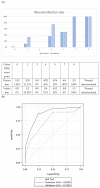Wound Infection of Snakebite from Venomous Protobothrops mucrosquamatus, Viridovipera stejnegeri and Naja atra in Taiwan: Validation of BITE and Cobra BITE Scoring Systems and their Bacteriological Differences in Wound Cultures
- PMID: 36668897
- PMCID: PMC9861491
- DOI: 10.3390/toxins15010078
Wound Infection of Snakebite from Venomous Protobothrops mucrosquamatus, Viridovipera stejnegeri and Naja atra in Taiwan: Validation of BITE and Cobra BITE Scoring Systems and their Bacteriological Differences in Wound Cultures
Abstract
Patients bitten by Protobothrops mucrosquamatus, Viridovipera stejnegeri, and Naja atra develop different degrees of wound infection. This study validated BITE and Cobra BITE scoring systems that we established previously. Bacteriological studies of patients with wound infection were conducted. The operating characteristic curves and area under the curve (AUC) and wound infection rates were compared between the derivation set (our previous study patient population) and the validation set (new patient cohorts enrolled between June 2017 and May 2021). No significant differences in the AUC for both the BITE (0.84 vs. 0.78, p = 0.27) and Cobra BITE (0.88 vs. 0.75, p = 0.21) scoring systems were observed between the derivation and validation sets. Morganella morganii and Enterococcus faecalis were the two most commonly detected bacteria in the microbiological study. More bacterial species were cultured from N. atra-infected wounds. Antibiotics such as amoxicillin with clavulanic acid, oxacillin, and ampicillin may not be suitable for treating patients with P. mucrosquamatus, V. stejnegeri, and N. atra bites in Taiwan. Carbapenem, third-generation cephalosporins, and fluoroquinolone may be superior alternatives.
Keywords: Naja atra; Protobothrops mucrosquamatus; Viridovipera stejnegeri; snakebites; wound infections.
Conflict of interest statement
The authors declare no conflict of interest.
Figures





References
-
- Chen C.-K., Lin C.-C., Shih F.-Y., Chaou C.-H., Lin J.C.-C., Lai T.-I., Tseng C.-Y., Fang C.-C. Population-based study of venomous snakebite in Taiwan. J. Acute Med. 2015;5:38–42. doi: 10.1016/j.jacme.2015.04.004. - DOI
-
- Liu C.-C., Chou Y.-S., Chen C.-Y., Liu K.-L., Huang G.-J., Yu J.-S., Wu C.-J., Liaw G.-W., Hsieh C.-H., Chen C.-K. Pathogenesis of local necrosis induced by Naja atra venom: Assessment of the neutralization ability of Taiwanese freeze-dried neurotoxic antivenom in animal models. PLoS Negl. Trop. Dis. 2020;14:e0008054. doi: 10.1371/journal.pntd.0008054. - DOI - PMC - PubMed
-
- Huang L.-W., Wang J.-D., Huang J.-A., Hu S.-Y., Wang L.-M., Tsan Y.-T. Wound infections secondary to snakebite in central Taiwan. J. Venom. Anim. Toxins Incl. Trop. Dis. 2012;18:272–276. doi: 10.1590/S1678-91992012000300004. - DOI
MeSH terms
Substances
LinkOut - more resources
Full Text Sources

